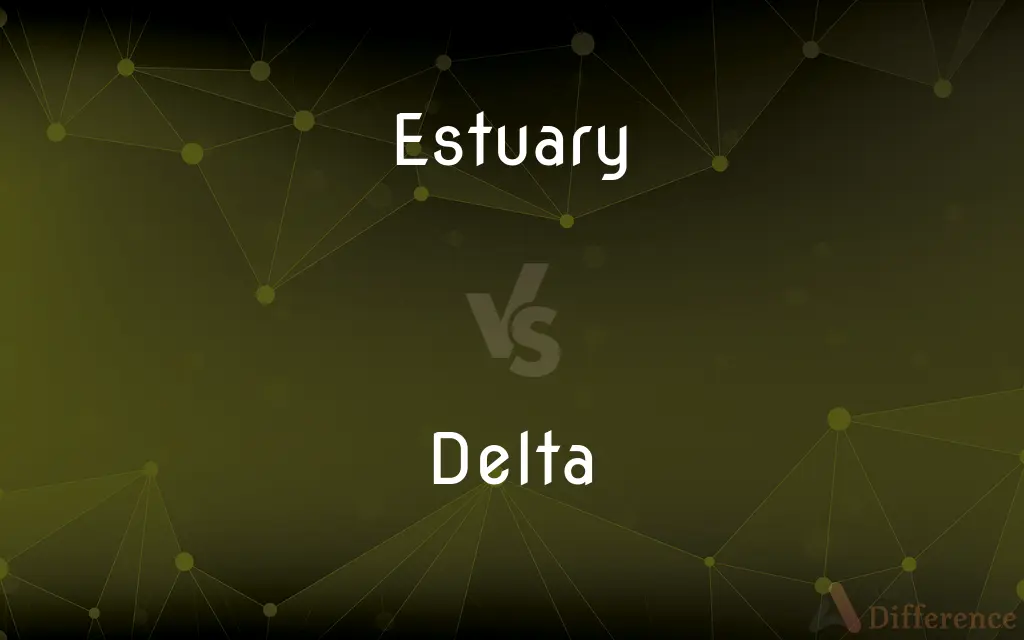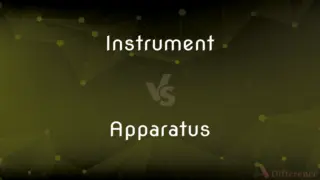Estuary vs. Delta — What's the Difference?
By Tayyaba Rehman & Urooj Arif — Updated on April 17, 2024
An estuary is a partially enclosed coastal body of water where freshwater from rivers mixes with seawater, whereas a delta is a landform at the mouth of a river created by sediment deposits.

Difference Between Estuary and Delta
Table of Contents
ADVERTISEMENT
Key Differences
An estuary is a dynamic ecosystem located at the interface between river environments and marine ecosystems, where salt water from the sea mixes with fresh water from rivers. This mixing zone is characterized by unique salinity gradients that support diverse biological communities. On the other hand, a delta is a distinct geomorphological feature formed at the mouth of a river, where sediment carried by the river water is deposited as it enters a slower-moving or standing water body like an ocean, sea, or lake.
Estuaries are known for their role as vital habitats for wildlife, providing breeding and feeding grounds for various bird species, fish, and other aquatic organisms. Whereas deltas are primarily recognized for their rich soil and dense vegetation, often hosting extensive wetlands that support a wide range of wildlife.
In terms of hydrology, estuaries act as buffer zones, stabilizing shorelines and regulating water quality by filtering pollutants and sediments. Deltas, however, are more prone to flooding but are crucial for agriculture due to their fertile land.
Estuaries are often subject to both oceanic and riverine influences, making them sensitive to changes in water level due to tidal movements. Deltas, by contrast, are shaped by sediment deposition patterns that can lead to the creation of intricate networks of channels and islands.
The management of estuaries focuses on maintaining water quality and protecting habitats, while delta management is often concerned with preventing erosion and managing land for agricultural use.
ADVERTISEMENT
Comparison Chart
Definition
A water body where river meets the sea and freshwater mixes with seawater.
Landform made of sediment deposited at a river’s mouth.
Key Features
Brackish water, tidal actions.
Sediment deposition, channel networks.
Ecological Role
Biodiversity hotspot, nutrient filtration.
Wetland habitat, supports diverse flora and fauna.
Water Movement
Tidal influence mixes water layers.
Slower water flow allows sediment to settle.
Primary Concerns
Pollution impact, habitat conservation.
Flooding, sediment management.
Compare with Definitions
Estuary
Influenced by tidal movements which affect salinity and water level.
The estuary's water salinity changes with the tides throughout the day.
Delta
Contains networks of channels and sometimes islands formed by sediment deposits.
The intricate network of waterways in the Ganges Delta supports a diverse ecosystem.
Estuary
A partially enclosed coastal area where freshwater mixes with seawater.
The Chesapeake Bay is one of the largest estuaries in the United States.
Delta
Prone to flooding but important for biodiversity.
Deltas frequently experience flooding but sustain unique wetland ecosystems.
Estuary
A vital habitat for birds, fish, and other wildlife.
Estuaries provide feeding grounds for migratory birds.
Delta
Often characterized by rich, fertile soil suitable for agriculture.
The Mississippi Delta region is a major agricultural hub due to its fertile soil.
Estuary
Acts as a critical nursery for marine species.
Many fish species spawn in the protected waters of estuaries.
Delta
Essential for bird species and aquatic life that thrive in nutrient-rich environments.
Deltas are crucial breeding grounds for many bird species.
Estuary
Key for filtering pollutants from rivers before they reach oceans.
Estuaries help to filter out sediments and pollutants, improving water quality.
Delta
A landform at the river’s mouth where it deposits sediment.
The Nile Delta is one of the most well-known deltas in the world.
Estuary
An estuary is a partially enclosed coastal body of brackish water with one or more rivers or streams flowing into it, and with a free connection to the open sea.Estuaries form a transition zone between river environments and maritime environments and are an example of an ecotone. Estuaries are subject both to marine influences such as tides, waves, and the influx of saline water and to riverine influences such as flows of freshwater and sediment.
Delta
The fourth letter of the Greek alphabet (Δ, δ), transliterated as ‘d’.
Estuary
The part of the wide lower course of a river where its current is met by the tides.
Delta
A code word representing the letter D, used in radio communication.
Estuary
An arm of the sea that extends inland to meet the mouth of a river.
Delta
A triangular tract of sediment deposited at the mouth of a river, typically where it diverges into several outlets
The Nile delta
A huge delta system developed
Estuary
A coastal water body where ocean tides and river water merge, resulting in a brackish water zone.
Delta
The fourth letter of the Greek alphabet. See Table at alphabet.
Estuary
An ocean inlet also fed by fresh river water.
Delta
An object shaped like a triangle.
Estuary
A place where water boils up; a spring that wells forth.
Delta
A usually triangular alluvial deposit at the mouth of a river.
Estuary
A passage, as the mouth of a river or lake, where the tide meets the current; an arm of the sea; a frith.
It to the sea was often by long and wide estuaries.
Delta
A similar deposit at the mouth of a tidal inlet, caused by tidal currents.
Estuary
Belonging to, or formed in, an estuary; as, estuary strata.
Delta
(Mathematics) A finite increment in a variable.
Estuary
The wide part of a river where it nears the sea; fresh and salt water mix
Delta
Being in the fourth position relative to a designated carbon atom in an organic molecule at which an atom or a group may be substituted.
Delta
Referring to the fourth of a group of isomers, or molecules of similar origin or properties, determined arbitrarily by those who discover or classify them. Used in combination.
Delta
The fourth letter of the modern Greek alphabet Δ, δ.
Delta
A landform at the mouth of a river where it empties into a body of water.
Delta
(international standards) nodot=1 NATO/ICAO Phonetic Alphabet.}}
Delta
(mathematics) The symbol Δ.
Delta
A small but noticeable effect. Compare epsilon.
This will slow the main code path down, but only by delta.
Delta
(computing) The set of differences between two versions of a file.
When you update the file, the system will only save the deltas.
Delta
A change in a quantity, likely from "d" for "difference".
ΔV - "delta vee"(change in velocity, used in rocketry and orbital mechanics)
Delta
(surveying) The angle subtended at the center of a circular arc.
Delta
A type of cargo bike that has one wheel in front and two in back.
Delta
The closed figure produced by connecting three coils or circuits successively, end for end, especially in a three-phase system.
Delta winding; delta connection; delta current
Delta
(finance) The rate of change in an option value with respect to the underlying asset's price.
Delta
(chemistry) A value in delta notation indicating the relative abundances of isotopes.
Delta
A military unit, nominally headed by a colonel, equivalent to a USAF operations wing, or an army regiment.
Delta
(astronomy) a star that is usually the fourth brightest of a constellation.
Delta
(physics) one of four baryons consisting of up and down quarks with a combined spin of 3/2: Δ++ (uuu), Δ+ (uud), Δ0 (udd), or Δ− (ddd)
Delta
(medicine) delta variant variant of the SARS-CoV-2 virus
Delta
(cryptography) To calculate the differences between the characters in an enciphered text and the characters a fixed number of positions previous.
Delta
(computing) To compare two versions of the same file in order to determine where they differ (where a programmer has made edits).
Delta
The fourth letter of the Greek alphabet (
Delta
A tract of land shaped like the letter delta (
Delta
The closed figure produced by connecting three coils or circuits successively, end for end, esp. in a three-phase system; - often used attributively, as delta winding, delta connection (which see), etc.
Delta
A low triangular area where a river divides before entering a larger body of water
Delta
The 4th letter of the Greek alphabet
Common Curiosities
Can both estuaries and deltas be found in any river system?
Not all rivers have estuaries or deltas; their formation depends on factors like the volume of water flow, sediment load, and the topography of the coastline.
Why are estuaries important to ecosystems?
Estuaries are crucial as they provide habitats for various species, serve as nurseries for fish, and act as filters to clean water before it reaches the ocean.
What measures are taken to protect estuaries and deltas?
Protection efforts include pollution control, restoration projects to maintain natural water flow, and conservation programs to protect wildlife habitats.
How do human activities affect deltas and estuaries?
Human activities, such as pollution, dam construction, and land development, can disrupt the natural processes and habitats in both deltas and estuaries.
What types of wildlife are typically found in estuaries?
Estuaries are home to numerous bird species, fish, crustaceans, and mollusks, all adapted to varying salinity levels.
What is the difference between an estuary and a delta?
An estuary is a water body where freshwater mixes with seawater, typically enclosed and influenced by tides, whereas a delta is a sediment-rich landform at a river’s mouth.
Can estuaries serve as economic resources?
Yes, estuaries support commercial fishing, tourism, and provide protection against coastal erosion, offering significant economic benefits.
How does sediment contribute to the formation of a delta?
Sediment carried by river water accumulates at the river’s mouth, forming deltas over time as it deposits and spreads into the receiving body of water.
Are deltas or estuaries more susceptible to climate change impacts?
Both are vulnerable, but deltas are particularly at risk from rising sea levels and increased storm surges due to their low-lying nature.
How do estuaries support biodiversity?
Estuaries provide a mix of fresh and saltwater habitats, rich nutrients, and varied topography that supports diverse species at different life stages.
What is the role of tides in shaping an estuary?
Tides play a crucial role in mixing water in estuaries, affecting salinity and nutrient distribution essential for the ecosystem.
What geological processes are involved in the formation of an estuary?
Estuaries form through the flooding of river valleys and coastal subsidence, combined with sea level changes that allow seawater to mix with river water.
How do deltas evolve over time?
Deltas evolve as sediment deposition continues, potentially forming new channels and islands, and changing shape due to natural and human-induced factors.
How do conservation efforts differ between estuaries and deltas?
Conservation in estuaries often focuses on water quality and protecting shorelines, while in deltas, efforts may focus more on sediment management and flood control.
What are the challenges in managing deltas?
Managing deltas involves dealing with flooding, ensuring sediment flow to maintain landforms, and addressing ecological impacts of agricultural runoff.
Share Your Discovery

Previous Comparison
Instrument vs. Apparatus
Next Comparison
Yarn vs. GimpedAuthor Spotlight
Written by
Tayyaba RehmanTayyaba Rehman is a distinguished writer, currently serving as a primary contributor to askdifference.com. As a researcher in semantics and etymology, Tayyaba's passion for the complexity of languages and their distinctions has found a perfect home on the platform. Tayyaba delves into the intricacies of language, distinguishing between commonly confused words and phrases, thereby providing clarity for readers worldwide.
Co-written by
Urooj ArifUrooj is a skilled content writer at Ask Difference, known for her exceptional ability to simplify complex topics into engaging and informative content. With a passion for research and a flair for clear, concise writing, she consistently delivers articles that resonate with our diverse audience.
















































